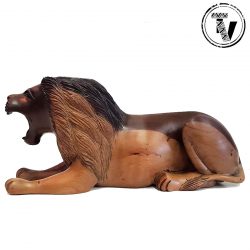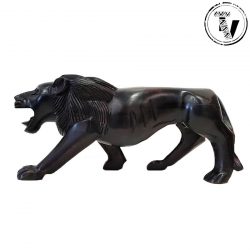Description
Large Lion Raku Pottery
Handcrafted by Community Projects Worldwide
South Africa
This project employs up to 30 people (mostly women & single mothers) in a area of high unemployment, providing ongoing training, access to medical facilities and assistance with loans. They also mentor employees in life and financial skills. More than half the employees have been working with them for 10 years. The families of longer serving employees have been assisted in funeral and ongoing living expenses.
Production Techniques
The production process is a very labour intensive one as all products are totally hand-made and hand decorated. Each piece passes through the hands of at least eight skilled artisans, many of whom etch or paint their initials on the bottom of each item.
1. The process starts with a solid model that is created by the designer, from which a master mold is made and then in turn a working mold or press mold is created. This is then used for general production of the model.
2. After the items are taken from the mold, excess clay is removed and the items are smoothed and a pattern is then etched into the wet clay
3. The first firing, also called the bisque firing, is done in an electric kiln at a temperature of 1000°C. It takes place once the clay has dried out sufficiently. This generally happens between one and three days after production. This firing takes about 12 hours with an additional 12 hours for the kiln to cool down.
4. After the first firing, the items are now know as ‘bisque ware’. The painters then hand-paint the bisque ware with Raku glaze and small brushes. After the painters have completed their task, each item is carefully transported to the kilns.
5. The Raku firing is the second and last firing and this time it takes place in a gas Raku kiln. The kiln cover is then removed and a little cooling-off takes place, during this stage the red hot clay body comes into contact with the much colder air around it and the glaze cracks as a result.
6. In the next important stage, the still-hot items are transferred to a waiting drum of sawdust where the Raku items smolder and the resulting smoke penetrates the fine cracks that were caused moments earlier. The cracks become black as a result of this process. The smoke also blackens the unglazed surfaces. After about 30 minutes the items are removed from the sawdust to cool down further.
7. Each item is then washed, carefully checked and packaged, ready for distribution.
This process is largely uncontrolled and slight imperfections make every piece a unique, ‘one of a kind’





